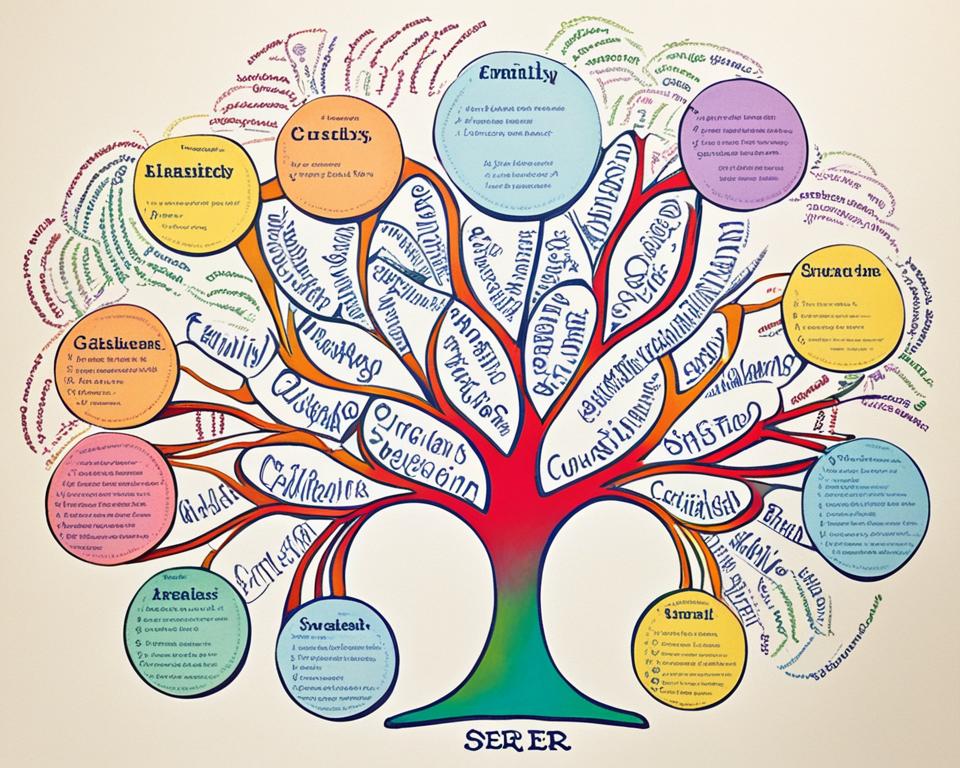¡Hola amigos! Are you ready to dive into the fascinating world of Spanish grammar? Today, we’ll be exploring the various uses of the verb “ser” and how it can enhance your language skills. Whether you’re a beginner or an advanced learner, understanding the correct usage of “ser” is crucial for mastering Spanish.
“Ser” is a versatile verb that plays a fundamental role in expressing identity, possession, origin, and more. By grasping the intricacies of using “ser” correctly, you’ll be well on your way to becoming a confident Spanish speaker.
Key Takeaways:
- Understanding the various uses of the verb “ser” is essential for mastering Spanish grammar.
- “Ser” is commonly used to express permanent characteristics, describe possession, talk about origin and nationality, and identify essential characteristics and relationships.
- “Ser” is also used in impersonal expressions and to express time, dates, and weather.
- Learning to use “ser” accurately will enhance your language skills and help you communicate effectively in Spanish.
- Practice incorporating “ser” into your conversations to become more fluent in Spanish.
Now that we’ve set the stage, let’s begin our journey into the different uses of “ser” in Spanish grammar. Get ready to unlock a world of linguistic possibilities!
Introduction to Ser

Before delving into the various uses of “ser” in Spanish grammar, it’s essential to have a basic understanding of this important verb. In this section, we will explore the conjugation, meaning, and pronunciation of “ser” to set the foundation for further learning.
“Ser” is an irregular verb that belongs to the group of essential verbs in Spanish. It is used to express identity, characteristics, origin, possession, and more. Mastering the usage of “ser” is crucial for building strong language skills and effectively communicating in Spanish.
Let’s begin by looking at the conjugation of “ser” in the present tense:
| Subject Pronoun | Verb Conjugation |
|---|---|
| Yo | soy |
| Tú | eres |
| Él/Ella/Usted | es |
| Nosotros/Nosotras | somos |
| Vosotros/Vosotras | sois |
| Ellos/Ellas/Ustedes | son |
The meaning of “ser” varies depending on the context in which it is used. It is often translated as “to be” in English, but it can also convey other meanings such as “to exist” or “to belong.”
Here’s an example illustrating the usage of “ser” to express identity:
Yo soy María. (I am María.)
As for pronunciation, the verb “ser” is pronounced as /ser/ with a strong emphasis on the “e” sound. Practice saying the conjugated forms of “ser” aloud to improve your pronunciation skills.
Now that we have covered the basics of “ser,” we can move on to exploring its different uses in Spanish grammar. Let’s dive in!
Key Takeaways:
- “Ser” is an essential verb in Spanish used to express identity, characteristics, origin, possession, and more.
- The conjugation of “ser” in the present tense includes forms such as “soy,” “eres,” “es,” “somos,” “sois,” and “son.”
- The meaning of “ser” can vary depending on the context, and it is often translated as “to be” in English.
- Remember to pronounce “ser” as /ser/ with a strong emphasis on the “e” sound.
Identifying Permanent Characteristics

One of the main uses of ser is to identify permanent characteristics in Spanish. These characteristics include nationality, occupation, and physical descriptions, which provide essential information about a person’s identity. Understanding how to use ser correctly is crucial for effective communication in Spanish.
When describing someone’s nationality, ser is the verb of choice. For example:
Él es mexicano. (He is Mexican.)
Ella es francesa. (She is French.)
Ser is also used to express a person’s occupation or profession:
Él es médico. (He is a doctor.)
Ella es maestra. (She is a teacher.)
In addition, ser is employed to describe physical characteristics. Here are some examples:
Él es alto y guapo. (He is tall and handsome.)
Ella es baja y morena. (She is short and dark-haired.)
Using ser to Identify Permanent Characteristics – Examples
| Nationality | Occupation | Physical Description |
|---|---|---|
| Él es mexicano. (He is Mexican.) | Él es médico. (He is a doctor.) | Él es alto y guapo. (He is tall and handsome.) |
| Ella es francesa. (She is French.) | Ella es maestra. (She is a teacher.) | Ella es baja y morena. (She is short and dark-haired.) |
Mastering the use of ser to identify permanent characteristics is essential for gaining a deeper understanding of the Spanish language and culture. By accurately describing who someone is, you can establish a stronger connection and engage in meaningful conversations.
Expressing Time and Dates

When it comes to expressing time and dates in Spanish, the verb “ser” plays a crucial role. Whether you need to talk about a specific day, month, or year, using “ser” correctly is essential. Let’s explore how to use this verb to convey time-related information.
Using Ser to Talk About Days and Months
When discussing the days of the week or months of the year, “ser” is used to indicate the day or month in question. Take a look at the following examples:
Hoy es miércoles. (Today is Wednesday.)
Mañana es viernes. (Tomorrow is Friday.)
El cumpleaños de Pablo es en abril. (Pablo’s birthday is in April.)
In these examples, “es” is used with specific days (miércoles, viernes) and months (abril) to express the day of the week or the month. This allows for clear and accurate communication regarding time and dates.
Discussing Years and Other Fixed Periods
In addition to days and months, “ser” can also be used to discuss years and other fixed periods of time. Let’s take a look at some examples:
El año es 2022. (The year is 2022.)
El concierto es el próximo mes. (The concert is next month.)
In these examples, “es” is used to express the specific year (2022) and the upcoming month. This allows for precise communication when discussing time and fixed periods.
By understanding how to use “ser” to express time and dates in Spanish, you’ll be able to convey information accurately and effectively. Practice using “ser” in different time-related contexts to enhance your language skills and become a more confident Spanish speaker.
Describing Possession

In addition to expressing permanent characteristics and identifying origin, the verb “ser” is also used to describe possession in Spanish. Whether you want to indicate ownership of objects or relationships, ser plays a crucial role in conveying possession accurately.
When discussing possession of objects, use the form of ser followed by the preposition “de” to indicate ownership. For example:
La casa es de Juan.
(The house belongs to Juan.)
In the same way, ser can be used to denote possession of relationships. For instance:
Juan es mi hermano.
(Juan is my brother.)
Remember to conjugate ser appropriately based on the subject of the sentence and use the correct form of the verb to maintain subject-verb agreement.
Using Ser to Describe Possession: Examples
To further clarify the use of ser in describing possession, let’s take a look at some examples:
| Subject | Possession | Example Sentence |
|---|---|---|
| Yo | A computer | El ordenador es mío. |
| Tú | A car | El coche es tuyo. |
| Él/Ella | A house | La casa es suya. |
In these examples, the form of ser (es) is used to express possession along with the corresponding possessive pronouns (mío, tuyo, suya) to indicate ownership.
By mastering the use of ser to describe possession, you will be able to communicate ownership and relationships with clarity and precision in your Spanish conversations.
Talking about Origin and Nationality

Ser, one of the most commonly used verbs in Spanish, plays a significant role in discussing a person’s origin and nationality. Whether you are conversing with a native Spanish speaker or simply exploring the language, understanding how to use ser in these contexts is crucial.
To express where someone is from, ser is employed to indicate origin. For example:
Mi amiga es de México.
This sentence translates to “My friend is from Mexico.” In this case, ser is used to identify the friend’s place of origin, which is Mexico. By utilizing ser and the appropriate preposition, like de, you can effectively communicate someone’s origin.
In addition to origin, ser is also used to specify someone’s nationality. Consider the following example:
Paulo es brasileño.
This sentence translates to “Paulo is Brazilian.” Here, ser is utilized to indicate Paulo’s nationality, which is Brazilian. By incorporating ser and the national adjective, you can accurately describe someone’s nationality in Spanish.
To further illustrate the usage of ser in expressing origin and nationality, here is a table summarizing the conjugation of ser in the present tense:
| Subject Pronoun | Conjugation of “Ser” |
|---|---|
| Yo | soy |
| Tú | eres |
| Él/Ella/Usted | es |
| Nosotros/Nosotras | somos |
| Vosotros/Vosotras | sois |
| Ellos/Ellas/Ustedes | son |
With the help of ser, you can confidently discuss someone’s origin and nationality in Spanish. Practice using ser in different contexts to enhance your language skills and broaden your cultural understanding.
Identifying Essential Characteristics and Elements

In addition to its other uses, the verb “ser” in Spanish can also help us identify essential characteristics or elements of a person, thing, or situation. By using “ser” correctly, we can effectively describe inherent qualities in our conversations and written expressions.
When using “ser” to describe essential characteristics, it is important to understand the agreement between the subject and the predicate. The conjugation of “ser” will vary depending on whether the subject is singular or plural, masculine or feminine. Let’s take a look at some examples:
- Ella es inteligente – She is intelligent.
- Ellos son amables – They are kind.
As illustrated above, the verb “ser” is conjugated differently based on the subject’s gender and number. This attention to detail allows for precise communication when describing essential characteristics and elements.
“Ser” nos permite destacar las cualidades esenciales de las personas, los objetos y las situaciones. Con su conjugación adecuada, podemos comunicarnos efectivamente y expresar estas características inherentes de forma precisa y clara.
Using “ser” to identify essential characteristics and elements adds depth to our descriptions and helps us portray a more accurate representation of the subject. Whether it’s describing someone’s personality traits or an object’s fundamental properties, the correct use of “ser” allows us to paint a vivid picture with our words.
To further enhance your understanding, let’s consider the following table:
| Singular | Plural |
|---|---|
| Yo soy | Nosotros/as somos |
| Tú eres | Vosotros/as sois |
| Él/Ella/Usted es | Ellos/Ellas/Ustedes son |
Take some time to study and familiarize yourself with the conjugation of “ser” in different contexts. Practicing with examples will help solidify your grasp of this essential Spanish verb.
Describing Relationships and Connections

Ser, the versatile Spanish verb, can also be used to describe relationships and connections between people or things. Understanding how to use ser in this context will allow you to effectively express familial relationships and other connections, fostering a deeper understanding of the Spanish language.
Expressing Familial Relationships
One of the key ways to use ser to describe relationships is to express familial connections. Let’s take a look at some examples:
| Spanish | English |
|---|---|
| Es mi padre | He is my father |
| Son mis hermanos | They are my siblings |
| Eres mi primo | You are my cousin |
In these examples, ser is used to express the familial relationship between individuals. By using ser, you can easily communicate the connection between family members.
Describing Other Connections
In addition to familial relationships, ser can also be used to describe other connections between people or things. Let’s explore some examples:
| Spanish | English |
|---|---|
| Somos amigos | We are friends |
| Es mi jefe | He/she is my boss |
| Eres mi compañero de clase | You are my classmate |
Using ser in these instances allows you to describe the connection or relationship between different individuals. It enables clear communication and enhances your language skills.
By understanding how to use ser to describe relationships and connections, you will be able to effectively communicate and express the intricate web of connections that exist between people and things. Embrace the power of ser and unlock a new level of Spanish language proficiency.
Exploring Impersonal Expressions

Ser, the versatile Spanish verb, plays a crucial role in expressing impersonal expressions. These expressions are commonly used to describe weather conditions, time, and general statements. Understanding how to use ser in these contexts will enhance your proficiency in Spanish. Let’s explore some common impersonal expressions:
Weather
When discussing weather conditions, ser is employed to convey the state of the atmosphere. Check out these examples:
| Impersonal Expression | English Translation |
|---|---|
| Es un día soleado | It is a sunny day |
| Hace calor | It is hot |
| Está lloviendo | It is raining |
Time and Dates
Ser is also used to express time and dates in Spanish. Here are some examples:
- Es la una
- It is one o’clock
Today is Saturday
Hoy es sábado
General Statements
Additionally, ser enables us to make general statements. Consider these examples:
- Es importante estudiar
- It is important to study
It is fundamental to speak Spanish
Es fundamental hablar español
Now that you have a better understanding of ser in impersonal expressions, you can elevate your Spanish skills by incorporating them into your conversations. Practice using these expressions to confidently discuss weather, time, and general statements.
Conclusion
In conclusion, understanding the different uses of ser in Spanish grammar is essential for effective communication. Whether you’re a beginner or an advanced learner, mastering ser will significantly enhance your language skills and help you express yourself accurately in any situation.
By incorporating ser into your conversations and practicing regularly, you can become more fluent in Spanish. Remember to focus on the various applications of ser such as identifying permanent characteristics, expressing time and dates, describing possession, talking about origin and nationality, identifying essential characteristics, describing relationships and connections, and exploring impersonal expressions.
With a deep understanding of the uses of ser, you’ll be able to confidently navigate Spanish conversations and convey your thoughts and ideas with precision. So, keep learning, practicing, and incorporating ser into your language journey to become a more proficient Spanish speaker.
FAQ
What is the verb “ser” in Spanish?
The verb “ser” is an important Spanish verb that is used to express a variety of concepts, including identity, characteristics, origin, possession, time, and more.
How do I conjugate the verb “ser”?
To conjugate the verb “ser” in Spanish, you need to change its form depending on the subject pronoun and tense. Common conjugations include “soy” (I am), “eres” (you are), and “es” (he/she/it is).
What are the different uses of “ser”?
The verb “ser” has various uses in Spanish grammar. It is used to identify permanent characteristics, express time and dates, describe possession and ownership, talk about origin and nationality, identify essential characteristics, describe relationships and connections, and express impersonal expressions such as weather or general statements.
How can I use “ser” to describe permanent characteristics?
“Ser” is used to identify permanent characteristics such as nationality, occupation, physical descriptions, and inherent qualities. For example, you can say “Soy estudiante” to mean “I am a student” or “Ella es alta” to mean “She is tall”.
Can “ser” be used to express time and dates?
Yes, “ser” is used to express time, dates, and other fixed periods. For instance, you can say “Son las nueve” for “It is nine o’clock” or “Es el sábado” for “It is Saturday”.
How do I use “ser” to describe possession?
To express possession or ownership, you can use “ser” with possessive pronouns such as “mi” (my), “tu” (your), or “su” (his/her/its). For example, “Es mi libro” means “It is my book”.
What is the role of “ser” in talking about origin and nationality?
“Ser” is often used to talk about one’s origin and nationality. For example, you can say “Soy de España” to mean “I am from Spain” or “Ella es mexicana” to mean “She is Mexican”.
How can I use “ser” to identify essential characteristics?
“Ser” is used to identify essential characteristics or elements of a person, thing, or situation. For instance, you can say “La honestidad es importante” to mean “Honesty is important”.
Can “ser” be used to describe relationships and connections?
Yes, “ser” can be used to describe relationships and connections between people or things. You can use it to express familial relationships such as “Ella es mi hermana” (She is my sister) or other connections like “Ellos son amigos” (They are friends).
In what context do we use “ser” in impersonal expressions?
“Ser” is often used in impersonal expressions to describe weather, time, and other general statements. For example, you can say “Es tarde” to mean “It is late” or “Es importante estudiar” to mean “It is important to study”.
Why is understanding the different uses of “ser” important?
Understanding the different uses of “ser” is crucial for effective communication in Spanish. Mastering “ser” will enhance your language skills and help you express yourself accurately in various situations.




